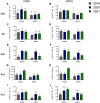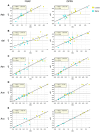Bioprospecting of Artemisia genus: from artemisinin to other potentially bioactive compounds
- PMID: 38413638
- PMCID: PMC10899597
- DOI: 10.1038/s41598-024-55128-z
Bioprospecting of Artemisia genus: from artemisinin to other potentially bioactive compounds
Erratum in
-
Author Correction: Bioprospecting of Artemisia genus: from artemisinin to other potentially bioactive compounds.Sci Rep. 2024 Jun 6;14(1):13027. doi: 10.1038/s41598-024-63761-x. Sci Rep. 2024. PMID: 38844757 Free PMC article. No abstract available.
Abstract
Species from genus Artemisia are widely distributed throughout temperate regions of the northern hemisphere and many cultures have a long-standing traditional use of these plants as herbal remedies, liquors, cosmetics, spices, etc. Nowadays, the discovery of new plant-derived products to be used as food supplements or drugs has been pushed by the exploitation of bioprospection approaches. Often driven by the knowledge derived from the ethnobotanical use of plants, bioprospection explores the existing biodiversity through integration of modern omics techniques with targeted bioactivity assays. In this work we set up a bioprospection plan to investigate the phytochemical diversity and the potential bioactivity of five Artemisia species with recognized ethnobotanical tradition (A. absinthium, A. alba, A. annua, A. verlotiorum and A. vulgaris), growing wild in the natural areas of the Verona province. We characterized the specialized metabolomes of the species (including sesquiterpenoids from the artemisinin biosynthesis pathway) through an LC-MS based untargeted approach and, in order to identify potential bioactive metabolites, we correlated their composition with the in vitro antioxidant activity. We propose as potential bioactive compounds several isomers of caffeoyl and feruloyl quinic acid esters (e.g. dicaffeoylquinic acids, feruloylquinic acids and caffeoylferuloylquinic acids), which strongly characterize the most antioxidant species A. verlotiorum and A. annua. Morevoer, in this study we report for the first time the occurrence of sesquiterpenoids from the artemisinin biosynthesis pathway in the species A. alba.
Keywords: Artemisia spp.; Antioxidants; Artemisinin; Bioprospection; Dicaffeoylquinic acids; Sesquiterpenes.
© 2024. The Author(s).
Conflict of interest statement
The authors declare no competing interests.
Figures








Similar articles
-
The biosynthesis of artemisinin (Qinghaosu) and the phytochemistry of Artemisia annua L. (Qinghao).Molecules. 2010 Oct 28;15(11):7603-98. doi: 10.3390/molecules15117603. Molecules. 2010. PMID: 21030913 Free PMC article. Review.
-
Functional Analysis of Amorpha-4,11-Diene Synthase (ADS) Homologs from Non-Artemisinin-Producing Artemisia Species: The Discovery of Novel Koidzumiol and (+)-α-Bisabolol Synthases.Plant Cell Physiol. 2016 Aug;57(8):1678-88. doi: 10.1093/pcp/pcw094. Epub 2016 Jun 7. Plant Cell Physiol. 2016. PMID: 27273626
-
Artemisinin biosynthesis enhancement in transgenic Artemisia annua plants by downregulation of the β-caryophyllene synthase gene.Planta Med. 2011 Oct;77(15):1759-65. doi: 10.1055/s-0030-1271038. Epub 2011 Apr 20. Planta Med. 2011. PMID: 21509717
-
Cellular engineering of Artemisia annua and Artemisia dubia with the rol ABC genes for enhanced production of potent anti-malarial drug artemisinin.Malar J. 2016 May 4;15(1):252. doi: 10.1186/s12936-016-1312-8. Malar J. 2016. PMID: 27142388 Free PMC article.
-
Biotechnological Approaches for Production of Artemisinin, an Anti-Malarial Drug from Artemisia annua L.Molecules. 2022 May 9;27(9):3040. doi: 10.3390/molecules27093040. Molecules. 2022. PMID: 35566390 Free PMC article. Review.
Cited by
-
Phytochemical Profile, Vasodilatory and Biphasic Effects on Intestinal Motility, and Toxicological Evaluation of the Methanol and Dichloromethane Extracts from the Aerial Parts of Ipomoea purpurea Used in Traditional Mexican Medicine.Pharmaceuticals (Basel). 2025 Jul 30;18(8):1134. doi: 10.3390/ph18081134. Pharmaceuticals (Basel). 2025. PMID: 40872525 Free PMC article.
-
Recovery of Bioactive Compounds from the Biomass of Aromatic Plants After Distillation Using NADES: A Sustainable Alternative Extraction Method.Molecules. 2025 Feb 28;30(5):1120. doi: 10.3390/molecules30051120. Molecules. 2025. PMID: 40076343 Free PMC article.
-
Effectiveness of Natural Products-Artemisia dubia and Manure Digestate-On Winter Wheat Cultivation.Plants (Basel). 2025 May 8;14(10):1411. doi: 10.3390/plants14101411. Plants (Basel). 2025. PMID: 40430977 Free PMC article.
References
-
- Oyemitan IA. African Medicinal Spices of Genus Piper. Elsevier; 2017. pp. 581–597.
-
- Süntar I. Importance of ethnopharmacological studies in drug discovery: Role of medicinal plants. Phytochem. Rev. 2020;19:1199–1209. doi: 10.1007/s11101-019-09629-9. - DOI
MeSH terms
Substances
LinkOut - more resources
Full Text Sources
Miscellaneous

